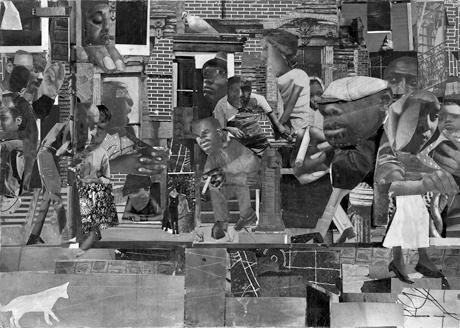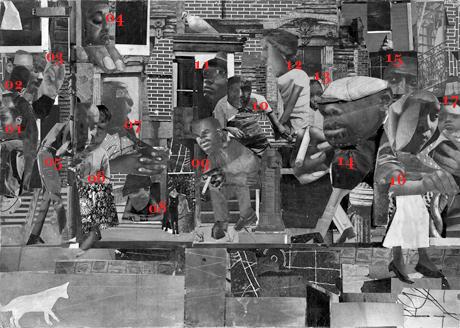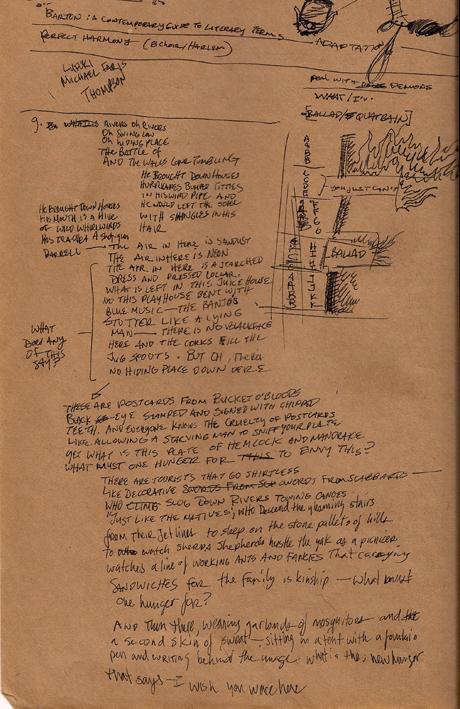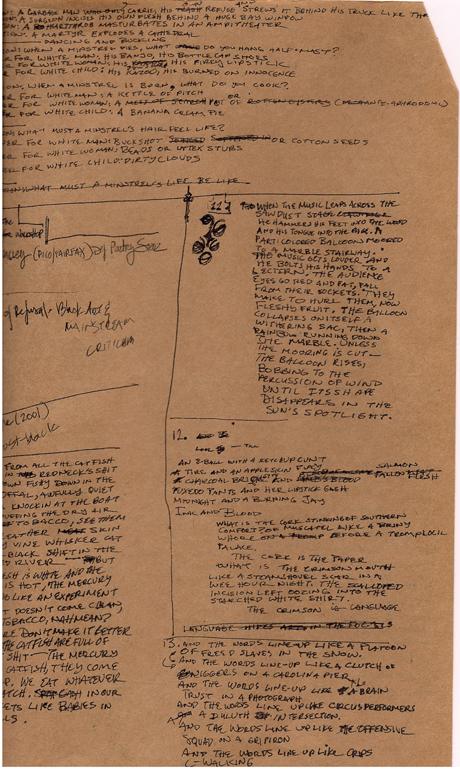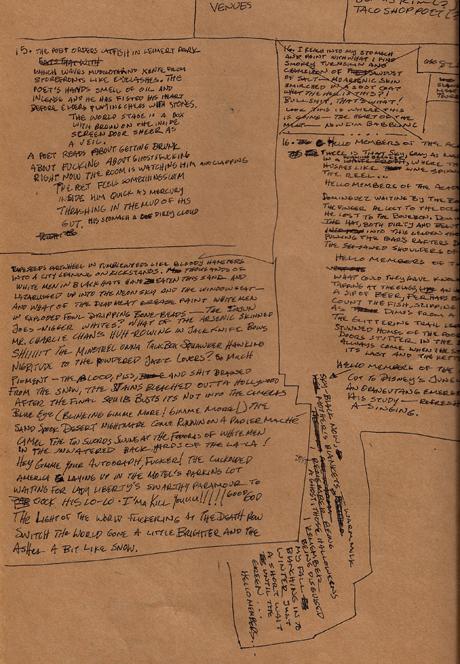169.
Ars poetica or arsehole poetica?
Subtitle: Why and how I wrote the long, obnoxious poem: “The Poet Writes the Poem That Will Certainly Make Him Famous.”
But first…
170.
171.
That’s “The Dove” by Romare Bearden. It messed me up for about six years.
172.
And since mess, for me, is the raw material of failure, the bones and meat of my work; being messed up by Bearden’s photomontage was disorienting and generative.
173.
I encountered “The Dove” in Romare Bearden in Black-And-White: Photomontage Projections, 1964 (edited by Gail Gelburd) and it was years before I knew the original image was in color. In the book’s black and white palette, the work had a stark blues and the documentarian heft of old snapshots. Yet for all the austerity and archival weight, Bearden’s composition manages clatter and clamor, the off-kiltered linteling is shanty and madcap. The huge hand with the cigarette both detail and myth.
174.
Somehow, in color, this tension is lost. Volume over muting. When the bricks are red, they are bricks, not an extension of any one figure who, when in color, is more immediately many figures collaged.
175.
This fragmentation is what unsettled me the most: a dismembering and re-membering in which the strategies for assembling the 17 people are the same as those for the city. Their bodies are the city’s, the crumbling brownstones the people’s flesh. Lives, lives, lives cut into concentrated figures wounded and wound on stoops, out jambs and frames.
176.
Only the animals are whole and one of them is blank, a ghost in a street of cardboard, wire and tile. The dove looks on.
177.
The book also featured an interview of Albert Murray where he described art as play, one in which the players keep themselves interested by increasing the degree of difficulty—he used Jacks as an example.
178.
The four classes of play—if I can recall, I no longer own the book: competition, make-believe, chance and vertigo.
179.
I’ve purchased the book twice. My first copy? Some guy bled all over it. First bright red, then dried to old brick.
The second, I gave to a visual artist at CalArts.
180.
But I remember what Murray said about vertigo: “Just spin around!”
Another generative disorientation.
181.
When I started messing with “The Dove,” I figured I would write a poem about each of the 17 figures. I would treat the image like a dramatis personae. Maybe make a chapbook. Simple!
182.
I stalled there for about three years.
183.
I think it’s because I kept looking at “The Dove” like the dove looked at the people. A monolithic subject observing integration and disintegration in a tense equilibrium. I wasn’t from there, I couldn’t speak the language.
184.
The breakthrough came at Cave Canem in 2001 in the form of a poem called “Skin&bones Seeks a New River.”
185.
Instead of treating the figures in “The Dove” as masks (a la a persona poem), I realized that I could treat them as mirrors (a bridge between the ekphrastic and the lyric).
186.
Each person became an avatar for an aspect of my personality or a syncretic representation of a memory of an event*. At left, behind a lamp post, Skin&bones—whom Bearden made cartoonishly skinny, nearly twined about a female figure—seemed a reflection of desire (see how he leans toward her); contentment; and via his bent posture which read to me as more than just adjusting for their height difference, ache.
187.
Here’s “The Dove” again; this time, numbered to indicate which figure triggered which poem.
01. “Bad Apple Puts His Piece On It”
02. “Br’er Parrot Learns His Own Song”
03. “Street Soldier Removes His Armor”
04. “Makerman Fumbles His Heart”
05. “Skin&bones Seeks A River”
06. “Pigeonmouth Wanders The Garden”
07. “Windowprez Chews Over Giving Back”
08. “Cellar Dweller Studies Black Magic”
09 “Fakir Floats Above Street Level”
10. “Halfaman Considers What He’s Borrowed”
11. “Shadowboxer On The Lookout”
12. “Messiah Dies For Their Sins”
13. “Baggage Attempts To Speak For The Mother”
14. “Corner-smolderer’s Diddy Bop”
15. “Wordsmith On The Way Down”
16. “Would Be Wildflower Laments The Seed”
17. “Low Sun Lights The Roots”
188.
Throughout, I nodded toward their fragmentation by writing each poem in sections, some parts were interrupted forms, chewed off conversations, disconnected outbursts. Over the course of the 17 poems and the two years from starting “Skin&bones” and finishing “Would Be Wildflower” the series, which I called The Dove Sessions, contains early attempts at a number of gestures I have come to articulate in other poems. “Br’er Parrot’s” list and “Pigeon Mouth’s” tumbling, end-to-end rhyme scheme have a descendant in “Floodsong 6: Bullfrog’s litany of the Eucharist.”
I hear the wind off the armies of flags
I hear the wind off the gardens of nerves
I hear the wind off the pageants of doves
I hear the wind off the towers of cogs
—from “Br’er Parrot Learns His Own Song”
and about me bends a dream
thin as a fish fin whisperssteam into my mouth fingers
vespers across my eyelidssing or swallow its command
rises I fall throat filling
—from “Pigeon Mouth Wanders the Garden”
equals:
my heart of trembling mud,
my blood of falling sand,
my mind of teeming fens,
my hands of moulding stones,
my bones of melting song,
—from “Floodsong 5: Bullfrog’s liturgy of the Eucharist”
Hell, “Bullfrog” is essentially a Dove Sessions poem.
190.
In order to sustain the texture of the poems over their extended composition, I listened to Charles Mingus’ The Black Saint and the Sinner Lady, another sectional self-mythologization. I wouldn’t listen to it any other time. My response to “Solo Dancer’s”opening shuffle of snare and hi-hat was damn near Pavlovian.
191.
Solo Dancer.
192.
Increase the degree of difficulty.
193.
The whole collection would then act as a performance piece where Bearden’s photomontage would either be projected and digitally animated or converted into complex costumes. There would be a solo dancer and some musicians.
194
Increase the degree of difficulty.
195.
Oh: I was to write one final poem. One for the dove itself: a self-cento collaged from the 17 poems.
196.
These bits never happened. By the time I finished the 17th poem, I was a bit tired of the world The Dove Sessions created. The constant “I” of every poem made me nervous about seeming self-aggrandizing (the lyric is one thing, but I feared thinking of the figures as mirrors—even fragmented mirrors—was perhaps more vain than self-interrogating). The clipped syntax (I was eschewing punctuation and using spaces to indicate pauses, I thought it might suggest Bearden’s cuttings) had me feeling a bit cramped. And the world was successfully austere as the black and white reproduction of the “the Dove”; yet, because the figures were now all essentially one—the poet—the teeming syncopation of Bearden’s photomontage, the angular multiplicity that gives it its vitality, disappeared.
197.
Several of the poems found homes. “Skin&bones” and “Halfaman” both appeared in the the Cave Canem “yearbook” anthologies (VI and VII, respectively). An early version of “Fakir” appeared in Callaloo and “Messiah” in a zine. “Br’er Parrot” appeared in a self-published chapbook, Atomic Buckdance. And “Shadowboxer On The Lookout” is the second poem in my first book, Fear, Some (Red Hen Press, 2006).
198.
Which brings us—at last—back to Fear, Some and its last poem. The long, obnoxious one. The arsehole poetica. “The Poet Writes The Poem That Will Certainly Make Him Famous.”
199.
It’s summer, 2003 and I was sick of The Dove Sessions. I wanted to write a looser line, to move from the fraught compression into a more discursive approach. I also wanted to deflate the self-seriousness I thought The Dove Sessions required. But most of all, I wanted to go big. If The Dove Sessions was chamber music, I wanted to write a symphony. And I wanted it to take less than two years.
200.
The process for writing the first draft of “The Poet Writes the Poem…” was fairly simple. Every day for one month, I would write a section of the poem. The next day, I would cover the previous sections up and write a new section building on whatever I could remember. If I couldn’t remember something or if I got tired of what I remembered, I could start a new digression. Here are some scans of original drafts from my journal.
201.
I did one early largescale revision, submitting it for a workshop in which we had to provide a long poem. This was the first time I allowed myself to actually build the poem from re-reading and not just memory. I kept many of the digressions. The nonce folk song (section 16) which led to the bits on mercury/Mercury (17, 18), the nods to Larry Levis (which acted also as nods to my teacher at the time, David St. John). Others.
202.
I didn’t touch the big monster again until I began working on the manuscript that became Fear, Some. When I knew “The Poet Writes the Poem…” would end the book, I revised it, riddling it with echos from other poems in the collection. In a sense, it swallowed the book, re-contextualizing and refreshing the content.
203.
I hope.
204.
Yet all of this could have been another exercise in self-mythologization if it weren’t for the fact that I made some discoveries as I wrote. And if it weren’t for The Dove Sessions which demanded rigorous emotional honesty I sometimes managed to deliver, I probably wouldn’t have been able to see, let alone follow, “The Poet Writes the Poem’s” crooked path through its briar patch of minstrelsy, resentments, cartoons and reticence about escape.
205.
What began to coalesce from the process was a satire of my experiences in “spoken word” and my movement into an “academic” space. I was one year deep in grad school at CalArts, I had finished my Cave Canem fellowship and though I was not ambivalent about how these contexts would impact my work, I was aware that others might be.
“The Poet Writes the Poem…” finds one of its motifs in the black blackfaced minstrel whom I imagine as a kind of performative surface. It dances, sings and you can write on it. This helped to elaborate the concept of “the poisonous coon”—the Trojan Horse figure who opens Fear, Some and mugs on the cover of the book.
206.
Joke:
What do you call a black man in black face?
A double niggative.
207.
What surprised me is how the minstrel developed into more than just a provocative metonym for black performance as spectacle (the poem’s title winks here), but an actual site on which to explore my aesthetics.
blackface is sometimes the truth
but with added emphasis. a boldface where
the smoldering cork testifies.
[the issue is intent, nahmean?
like what is nahmean when you see
knows its way around the alleys
of the tongue? what is nahmean, nahmean?
and the intent is the issue, you see?] [nahmean?]
blackface is sometimes a lie
but with added detail. a bold face where
the smoldering cork testifies.
—from “The Poet Writes the Poem That Will Certainly Make Him Famous”
That’s from section 1.
Section 6: “I’ll use my skin for paper.”
Section 8: “these words are burning cork, near a mirror.”
Section 13:
the cork is the words.
what is the crimson mouth like a scalloped incision
left oozing into the pressed, white shirt?
the mouth is language.
208.
The poem chases a kind of intellectual clarity in contrast with The Dove Sessions’ focus on atmosphere and mood. This isn’t an argument for the superiority or separation of either mode, rather a re-emphasis of “The Poet Writes the Poem…” as an effort to write myself away from The Dove Sessions and what that yielded. A prickly, cannibalistic poem about being difficult, maybe. Even so. as I re-read the poem now, I notice that there may be a more direct critique of my efforts at The Dove Sessions.
After a description of a blasted-brownstoned, ghetto tableau in D.C. (where I did my undergrad): “these are not my muses.//they aren’t even mirrors.”
209.
Realizations like that—sometimes delayed, sometimes hard won—are why I am a poet. Even when what I learn threatens to disintegrate something, poetry helps me re-integrate it. It helps me strive toward wholeness, one piece at a time.
*Except “Cornersmolderer” and “Street Soldier” which reveal themselves unintentionally as masks that never quite fit. Fail. The former is a nearly successful bop however, using The Roots’ “The Next Movement” as a source. The line: “The ghetto is red hot, we steppin on flames.”
Poet, interdisciplinary writer, and performer Douglas Kearney’s full-length poetry collections include...
Read Full Biography


